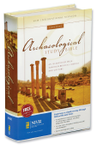As we continue profiling the Study Bibles from this month’s sale, today we will take an at-a-glance look at the Archaeological Study Bible.
Title: The Archaeological Study Bible
Area of Focus: Archaeology and Ancient Civilizations
Contributors: Walter C. Kaiser Jr. and Duane Garrett are the editors. Dr. Kaiser is distinguished professor emeritus of Old Testament and president emeritus of Gordon-Conwell Theological Seminary. Dr. Garrett is Professor of Old Testament Interpretation at Southern Baptist Theological Seminary.
Description: The Archaeological Study Bible is geared towards people who want to better understand the historical context of the Bible. Features include full color photographs of biblical places and objects, as well as in-text color maps that help readers enter into the world of the Bible. In addition to the verse notes, there are a lot of articles—520 to be exact. Each article is brief, yet informative, and falls into one of five main categories: Archaeological Sites, Cultural and Historical Notes, Ancient Peoples and Lands, the Reliability of the Bible, and Ancient Texts and Artifacts.
Sample Article
Song of Songs 3: Weddings in Ancient Israel
A wedding, as the public solemnization of an agreement made at the time of an engagement, was an occasion for great joy. The ceremony itself most likely consisted of the recitation of a simple formula, such as the one alluded to at the time of the first union between a husband and a wife (Ge 2:23). Marriage contracts from the Jewish community of Elephantine of the fifth century B.C. record a vow common to the ancient world: The groom would declare that the woman was his wife and that he was her husband for eternity. The wedding ceremony also may have involved the symbolic act of the man covering his bride with the corner of his garment to indicate that she was now under his protection and that it was his responsibility to provide for her (Ru 3:9; Eze 16:8). Blessings of fruitfulness were bestowed upon the couple by family and friends (Ge 24:60; Ru 4:11–12).
A passage from the Babylonian Talmud tells us that at a Jewish wedding in the early Christian era a groom would wear a ceremonial crown and receive his bride, who would make her entrance at the wedding party in a sedan chair. This event may explain the description in Song of Songs 3:6–11; it would appear that the bride was riding in such a sedan chair (NIV, “carriage”), accompanied by an honor guard. (In the phrase “Who is this?” in v. 6 the word “this” is feminine, referring to a woman.) The bride’s entourage also included a musical procession (Ps 45:14; 1Mc 9:37–39). The groom was attired in festive headdress (SS 3:11; Isa 61:10), and the bride was adorned in embroidered garments and jewelry (Ps 45:13–14; Isa 49:18; 61:10). A veil completed the virgin bride’s costume, which may partly explain the success of Laban’s ruse of substituting Leah for Rachel on Jacob’s wedding night (Ge 29:23; SS 4:1).
Jesus’ parable of the wise and foolish virgins (Mt 25:1–13) describes the arrival of the groom during the night prior to a wedding. He was attended by male companions, one of whom would serve as his best man (Jdg 14:20; Jn 3:29). Upon his arrival the groom’s family would host a feast (Mt 22:2; Jn 2:9). Putting the evidence together, it appears that the groom with his companions would traditionally arrive at the ceremonial house first, during the night, to be received by a group of young women. Early the next day the friends of the groom would go out to bring back the bride, who would arrive in a sedan chair with the groom’s friends as her symbolic honor guard…


